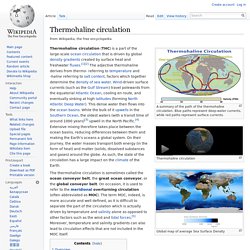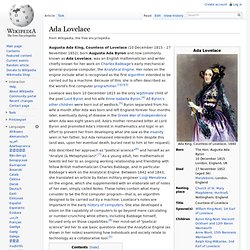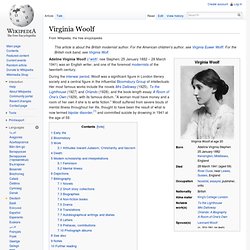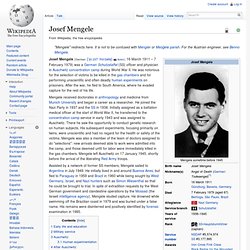

Thermohaline circulation. A summary of the path of the thermohaline circulation.

Blue paths represent deep-water currents, while red paths represent surface currents. Global map of average Sea Surface Density The thermohaline circulation is sometimes called the ocean conveyor belt, the great ocean conveyor, or the global conveyor belt. On occasion, it is used to refer to the meridional overturning circulation (often abbreviated as MOC). The term MOC, indeed, is more accurate and well defined, as it is difficult to separate the part of the circulation which is actually driven by temperature and salinity alone as opposed to other factors such as the wind and tidal forces.[5] Moreover, temperature and salinity gradients can also lead to circulation effects that are not included in the MOC itself. Overview[edit] Brian Cox (physicist) Brian Edward Cox OBE (born 3 March 1968)[1] is an English physicist and former musician, a Royal Society University Research Fellow, PPARC Advanced Fellow at the University of Manchester.[13][14] He is a member of the High Energy Physics group at the University of Manchester, and works on the ATLAS experiment at the Large Hadron Collider (LHC)[15][16] at CERN, near Geneva, Switzerland.

He is working on the research and development project of the FP420 experiment in an international collaboration to upgrade the ATLAS and the CMS experiment by installing additional, smaller detectors at a distance of 420 metres from the interaction points of the main experiments.[17][18][19][20] Cox's parents were bankers[1] and he attended the independent Hulme Grammar School[24] in Oldham from 1979 to 1986.[25][26][27] Cox revealed on The Jonathan Ross Show that he performed poorly on his Maths A-level: "I got a D ... I was really not very good ... I found out you need to practise.
Ada Lovelace. Augusta Ada King, Countess of Lovelace (10 December 1815 – 27 November 1852), born Augusta Ada Byron and now commonly known as Ada Lovelace, was an English mathematician and writer chiefly known for her work on Charles Babbage's early mechanical general-purpose computer, the Analytical Engine.

Her notes on the engine include what is recognised as the first algorithm intended to be carried out by a machine. Because of this, she is often described as the world's first computer programmer.[1][2][3] Ada described her approach as "poetical science" and herself as an "Analyst (& Metaphysician)". As a young adult, her mathematical talents led her to an ongoing working relationship and friendship with fellow British mathematician Charles Babbage, and in particular Babbage's work on the Analytical Engine. Biography[edit] Childhood[edit] Ada, aged four On 16 January 1816, Annabella, at George's behest, left for her parents' home at Kirkby Mallory taking one-month-old Ada with her. Ada Lovelace. T. S. Eliot. Virginia Woolf.
Adeline Virginia Woolf (/ˈwʊlf/; nee Stephen; 25 January 1882 – 28 March 1941) was an English writer, and one of the foremost modernists of the twentieth century.

During the interwar period, Woolf was a significant figure in London literary society and a central figure in the influential Bloomsbury Group of intellectuals. Steampunk. "Maison tournante aérienne" (aerial rotating house) by Albert Robida for his book Le Vingtième Siècle, a 19th-century conception of life in the 20th century Steampunk also refers to any of the artistic styles, clothing fashions, or subcultures, that have developed from the aesthetics of steampunk fiction, Victorian-era fiction, art nouveau design, and films from the mid-20th century.[3] Various modern utilitarian objects have been modded by individual artisans into a pseudo-Victorian mechanical "steampunk" style, and a number of visual and musical artists have been described as steampunk.

History[edit] Precursors[edit] Origin of the term[edit] Dear Locus,Enclosed is a copy of my 1979 novel Morlock Night; I'd appreciate your being so good as to route it Faren Miller, as it's a prime piece of evidence in the great debate as to who in "the Powers/Blaylock/Jeter fantasy triumvirate" was writing in the "gonzo-historical manner" first. Josef Mengele. "Mengele" redirects here.

It is not to be confused with Mengler or Meņģele parish. For the Austrian engineer, see Benno Mengele. Josef Mengele (German: [ˈjoːzɛf ˈmɛŋələ] ( ); 16 March 1911 – 7 February 1979) was a German Schutzstaffel (SS) officer and physician in Auschwitz concentration camp during World War II. He was notorious for the selection of victims to be killed in the gas chambers and for performing unscientific and often deadly human experiments on prisoners.
Mengele received doctorates in anthropology and medicine from Munich University and began a career as a researcher. Assisted by a network of former SS members, Mengele sailed to Argentina in July 1949. Early life and education Mengele was born the eldest of three children on 16 March 1911 to Karl and Walburga (Hupfauer) Mengele in Günzburg, Bavaria, Germany. In 1935, Mengele earned a PhD in anthropology from the University of Munich.